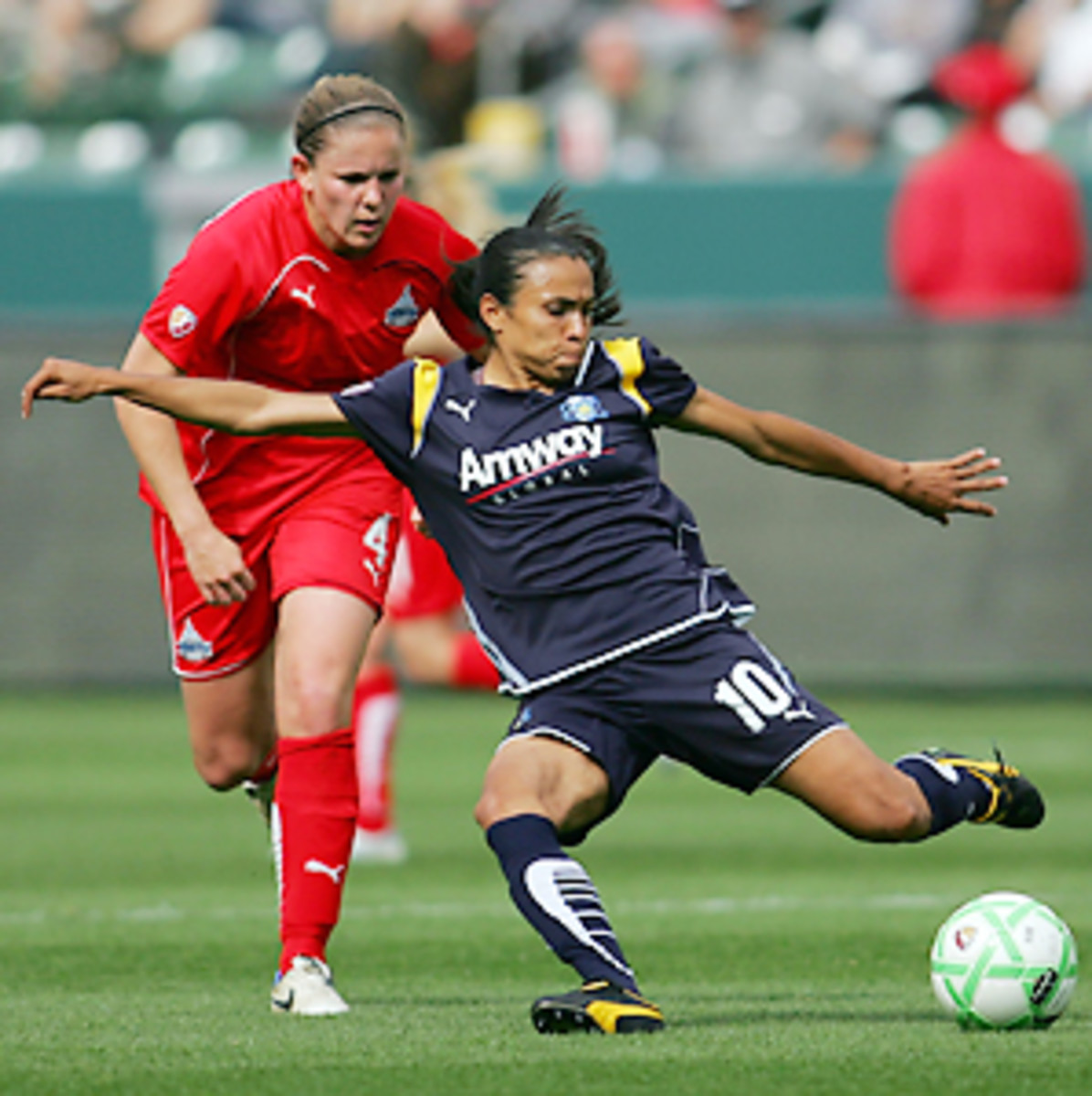
WPS rebuilt it, now will they come?
The world's best soccer player scored two goals Sunday in ... Bridgewater, N.J.
Marta, a player who only needs the same one-name distinction as other famous Brazilian stars, such as Kaká and Pelé, struck twice to guide the Los Angeles Sol to victory against Sky Blue FC in the first full weekend of the inaugural season of Women's Professional Soccer.
League officials must have breathed a sigh of relief. Marta is the biggest draw in women's soccer, and her status at the top of the game legitimizes WPS as the highest echelon of competition.
That credibility is crucial to the women's league, which already is battling two major negative factors. First, with discretionary spending down due to the worldwide recession, it's hard to imagine a worse time to launch a sports and entertainment enterprise. Second, WPS is battling the ghost of the departed Women's United Soccer Association.
Basically, the last memory many Americans have of a women's soccer league is of the one that folded six years ago. So the association taints WPS with failure even as the league takes a few tottering steps forward to try to avoid that fate.
But the WUSA didn't die in vain. It made clear to the organizers of WPS that they couldn't look to the near-90,000 crowd at the 1999 Women's World Cup final at the Rose Bowl as indicative of the numbers a new league would pull. Thus the venues for the seven WPS teams are smaller. That way, a crowd of 6,000 or so can be deemed a sellout. The modest expectations mean the league isn't looking to stunning attendance numbers to maintain viability.
The WUSA's demise also pointed out the folly of standing alone when trying to build soccer in the United States. Many of WPS' teams are working more closely with Major League Soccer, drawing on staff and resources and even tapping into the different fan bases. Collaboration efforts between WPS and MLS teams are expected to include doubleheaders.
"We're all there doing our part," Marta said when asked what would help the WPS survive when WUSA failed. "That's all we can do."
Good intentions and lessons learned aside, WPS exists as an entertainment entity. Not all of the potential audience was as primed as soccer superfan KobeBryant, who welcomed Marta to L.A. in a televised event last month and promised to bring his family to matches. "I'm so excited," Bryant said of WPS. "It's going to be great."
All the teams avoided the dreaded scoreless tie in the opening full weekend of WPS games. While some goals were scored by players who had even diehards reaching for the game program, other names were instantly recognizable to many. England's Kelly Smith scored for the Boston Breakers in a losing effort against FC Gold Pride. Both American veteran Tiffeny Milbrett and Japan's Afro-sporting ErikoArakawa notched for FC Gold Pride. Another American, Lindsey Tarpley, had the winning goal for the Chicago Red Stars against St. Louis Athletica.
St. Louis is an example of something else the league may be doing right: It's going into cities and communities where MLS hasn't yet reached. That means some WPS teams have the potential to be the big draw in soccer for the region, growing the game even as they expand their own fan base. How Athletica is supported could be a hint of future interest in an MLS team in that area.
In the end, everything may not come down to the soccer itself. It's a business, after all, and money must be made somewhere along the line or the plug will be pulled. If you judge WPS on the soccer alone, and assume a perfect world where the rest would take care of itself -- well, even in that scenario, the league is a bit shaky. Of course, you expect those opening matches to have awkward touches, bizarre passes to teammates cutting in different directions and airball shots.
Yet women's soccer has a combination of appealing factors on just watchability alone. It's an understandable game, even for novices. They might miss the subtleties, but everyone understands what happens when a ball crosses the line (minus that pesky offside caveat). In women's soccer, players often are more vocal, talking teammates through game strategy and giving instructions. It's insightful just to listen to a match and, because the crowds are small, it's quite easy to hear what players are saying. Though the effort at team unity and progress is obvious, players like Marta are intriguingly surprising -- popping out inspired bits of individual brilliance to help turn a match in their team's favor.
However, many successful women's sports, such as tennis and golf, have a bit of a "catfight" element to them that, for better or for worse, often draws in more casual fans. The league hasn't teased that storyline, but should it do so, it could attract fans as the season progresses. After all, many sports fans who have never watched a women's soccer match know that goalkeeper Briana Scurry controversially replaced Hope Solo on the U.S. team during the Women's World Cup in 2007 and that a huge backlash followed. The Americans promptly lost to Marta's Brazil squad. All the involved participants are playing for WPS teams, and their club clashes could feature an extra bit of heat that fans might be curious to check out.
That's the main question after the excitement of starting the league wears off. Will fans come in the numbers needed to sustain WPS? It's obvious that if there wasn't such doubt about the future, columns like this one wouldn't be speculating about what might happen in the days to come.
Instead, it might be a piece focused on how Marta could easily surpass David Beckham's soccer achievements in L.A. and bring a soccer title to the city. In a perfect world, that's what happens to the best around.





